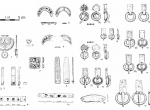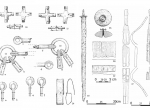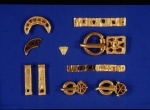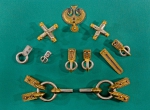Jakuszowice
Jakuszowice, Kazimierza district, Świętokrzyskie Voivodeship, site of discovery, in 1911, during sand extraction on the left-hand terrace of the Nidzica, at a depth of 6 m, of an inhumation with a rich grave inventory (dress accessories, weapons, horse harness fittings - fig. 1-2.) and unburnt remains of a horse (no data on context). The finders split most of the finds among themselves; to evade the interest of Russian authorities (J. were then in the part of Poland annexed by Russia) the assemblage was smuggled across the border to Krakow where it was acquired by the National Museum (in 1938 it entered the Archaeological Museum in Krakow). According to a specialist assessment made by J. Talko-Hryncewicz: "the individual was not too strongly developed, possibly of the male sex, young of age" (this cannot be confirmed as the skeletal remains are now missing). The surviving items from the grave inventory include a two-edged sword with a bar crossguard (a spatha of Asian type), scabbard (surviving silver-bronze chape, type Gundremmingen, and ornamental gold foil plating) and an amber sword bead (alternate interpretation - pommel), with gold foil and almandine appliqué; horse harness fittings: iron bit with silver rings, gilt silver buckle chapes stamp-decorated in Sösdala style →Sösdala-Untersiebenbrunn Style, two gilt silver-bronze cruciform bridle strap separators, possibly, also a gilt silver pelta-shaped pendant decorated with niello and stamped ornament, buckles and appliqués; three gold buckles ornamented in →Polychromic Style ; four silver buckles stamp-ornamented in Sösdala style (three of them gilt); a silver loop shaped belt buckle; a gilt silver strap-end, type Madyda-Legutko 13.1 with a stamped ornament; two gold strap-ends, type Madyda-Legutko 14, set with almandines; two gold crescent-shaped (lunula) pendants decorated in Polychromic style; a triangular gold foil appliqué; 11 fragments of embossed gold foil identified by Gy. László as plates of a symbolic reflex bow (symbol of authority exercised in the name of the →Huns ; the bow’s lack of functionality is suggested by its technical details and small size, i.e., a span of a mere 80 cm as compared to the nearly twice as long Hunnic weapons); iron knife in a wooden sheath; fragment of a grey-fired pottery vessel (wheel-thrown?). Chronology: phase D2 (until early 430s). The inventory includes obvious elements of Hunnic culture →Huns (objects in →Polychromic Style , weapons, including the symbolic bow, loop shaped belt buckle, possibly, the absence of brooches) and other forms characteristic for Sösdala-Untersiebenbrunn horizon →Sösdala-Untersiebenbrunn Style (stamped ornament). The assemblage is usually interpreted as a burial of a member of Przeworsk Culture elite, his position established thanks to contacts with the Huns. A nearby settlement at J., site 2 recognized as a major Przeworsk Culture centre, yielded material attributable to the an early →Migration Period settlement horizon but, so far, no evidence on contacts with the Hunnic environment.
BK
Literature: J. Żurowski, IV. sprawozdanie Urzędu Konserwatorskiego na okręg krakowski, "Wiadomości Archeologiczne" VI, 1921, p. 169-180; Gy. László, The Significance of the Hun Golden Bow, Acta Archaeologica Academiae Scientiarum Hungaricae I, 1951, p. 92-96, Tab. XVIII–XIX, XXI; S. Nosek, Tombe d’homme, à inhumation, Jakuszowice distr. de Pińczów, dép. de Kielce, Inventaria Archaeologica Pologne II, 1959, Tab. 15; K. Godłowski, Das „Fürstengrab” des 5. Jhs. und der „Fürstensitz” in Jakuszowice in Südpolen, [in:]: F. Vallet, M. Kazanski (Ed.), La noblesse romaine et les chefs Barbares du IIIe au VIIe siécle, Paris 1995, s. 155-179; P. Kaczanowski, J. Rodzińska-Nowak, Hunowie na ziemiach polskich. Próba podsumowania problematyki, [in:] Peregrinationes archaeologicae in Asia et Europa Joanni Chochorowski dedicatae, Kraków 2012, p. 371-373; A. Bursche, J. Kowalski (ed.), Barbarzyńskie Tsunami - Okres Wędrówek Ludów w dorzeczu Odry i Wisły, Warszawa-Szczecin 2017.
-
 full resolution
full resolution
Fig. 1. Jakuszowice - selected finds.
-
 full resolution
full resolution
Fig. 2. Jakuszowice - selected finds.
-
 full resolution
full resolution
Fig. 3. Jakuszowice - selected finds.
-
 full resolution
full resolution
Fig. 4. Elements of horse harness from grave uncovered in Jakuszowice, Kazimierza District, end of 4th – 1st half of 5th c.; collection of the Archaeological Museum in Kraków/Cracow; (phot. by A. Susuł)


